Weighing The Ingredients: Whole Grain Baguette Buns With Extra Sourdough Kick
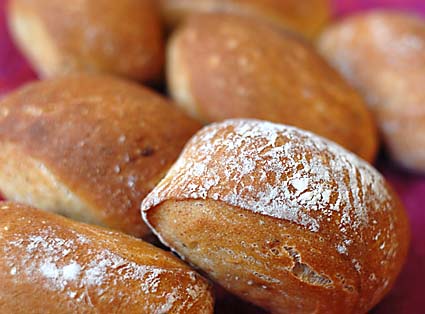
In this post, I’ll go through the method for using a kitchen scale to measure in flour and other ingredients, which some readers, especially outside the U.S., have said they prefer. In this recipe for whole grain baguette buns, I used these weight equivalents for scoop-and-swept cup measures:
1 cup white all-purpose flour: 5 ounces / 140 grams (or 141.7, to be more precise)
1 cup whole wheat flour: 4.5 ounces / 130 grams (127.6)
1 cup water: 8 ounces / 225 grams (226.8)
Most home scales aren’t accurate enough to weigh small quantities of yeast and salt for single recipes.
These whole grain baguette buns are from The New Artisan Bread in Five Minutes a Day, being cut from a baguette-shaped cylinder, which gives the buns crusty little edges that will impress your guests. They’re incredibly easy to make from any of the lean stored doughs that you already have in your fridge, mixed up from our book.
I was in a great restaurant recently, and they served baguette buns, which were delicious but the slightest bit stale. Breads this small go stale fast, and really, the best way to enjoy them is at home, an hour or two after they come out of the oven—and you can even eat these a touch warm and the center won’t seem unready. So here’s how to do it.
First, let’s use some old dough to kick up the sourdough flavor. In the book, we say “never wash the dough bucket,” because that old dough gives sourdough flavor a head start in the next stored batch. You can take that further, by using up to a pound of old dough in the next batch. The problem is getting that sticky dough to incorporate in the water before adding flour. An immersion blender is the best tool I’ve found for that job. I have the Braun MR430HC, but the Cuisinart looks good too. Same for the Kitchen-Aid Immersion Blender. Or just let it sit in the water, and then break it up with a fork.
First measure in some dough. Since I’m going to show you how to use the new-fangled easy-zeroing digital scales to weigh out ingredients, we may as well measure out exactly one pound of dough (I use a Salter Scale, but the Escali is also good). Put your dough bucket on the scale, press the “zero” button, and add dough until it reads 1 pound:

Now, press the zero button again and add water by weighing it. Instead of spooning 3 cups of water (this will be our light whole wheat recipe on page 131 of New Artisan), just weigh the equivalent amount—it’s 24 ounces U.S. (1 pound 8 ounces). Now that the water’s in there, you can use the immersion blender to create a uniform slurry of the old dough, but first, throw in 1 tablespoon of yeast. We test with Red Star Active Dry, Quick-Rise, or Platinum…
… and 1 to 1.5 tablespoons of coarse salt (like kosher salt), based on your taste. Be very careful with the blade end of the immersion blender. Unlike a food processor, there’s no safety interlock to prevent you from touching the blades while they’re running. Don’t let children use an immersion blender:
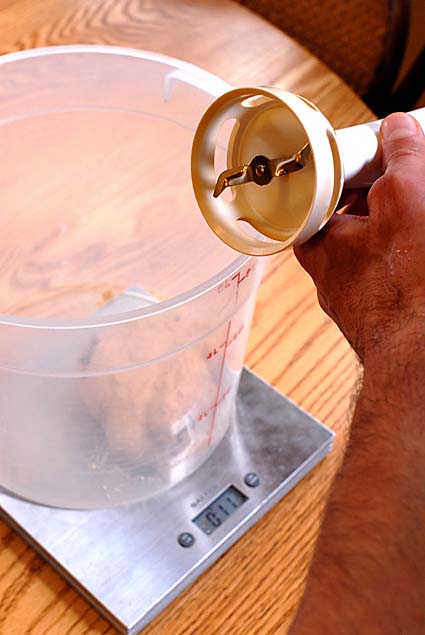
When the coast is clear, let it rip, keeping the head of the immersion blender submerged (or you will get splashed!):
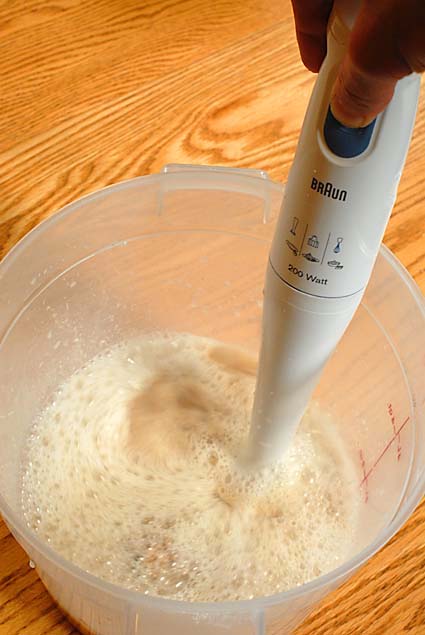
Now put the bucket back on the scale, hit the “zero” button again, and weigh in 2 pounds (32 U.S. ounces) of flour (I used a mixture of all-purpose and whole wheat in a ratio of about 5:1 all-purpose:whole wheat to give the result in the Light Whole Wheat recipe on page 74). If you’re using cup-measures, it’s 5 1/2 cups of white flour and 1 cup of whole wheat. White all-purpose flour weight about 5 ounces per cup, and whole wheat weigh about 4.5 ounces per cup, but at this ratio, it’s very close to 2 pounds total flour (32 ounces). Learn more about mixing our doughs.
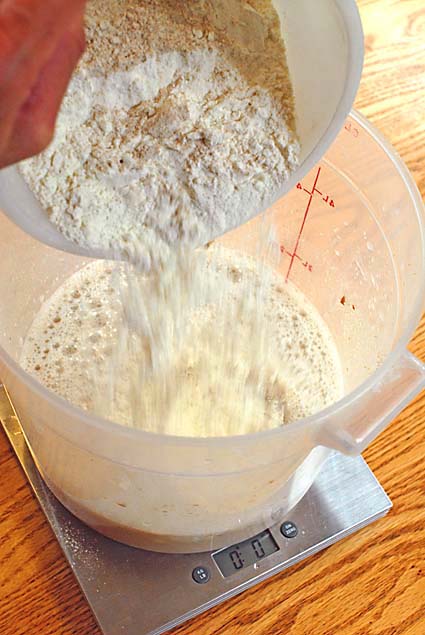
Mix it in with a spoon:
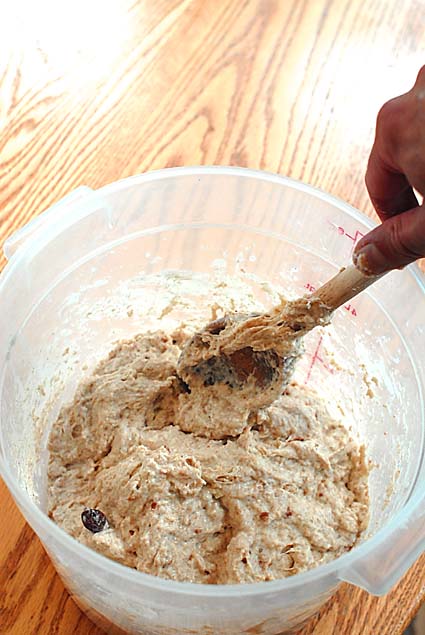
…and the dough is ready after about two hours at room temperature:
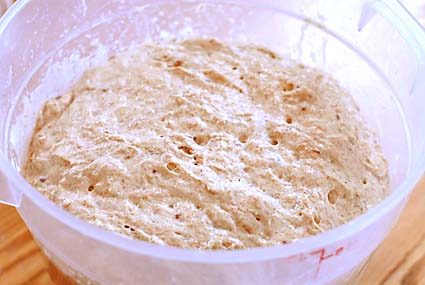
Store the bucket in the fridge for up to two weeks and tear off chunks as you need it (vent the bucket in the first few days by keeping it open a crack). For the whole grain baguette rolls, form a beautiful baguette using the letter-fold technique (see Zoe’s earlier post on this). Then, using a dough scraper or a knife, make angled parallel cuts about 2 inches apart along the length of the baguette:
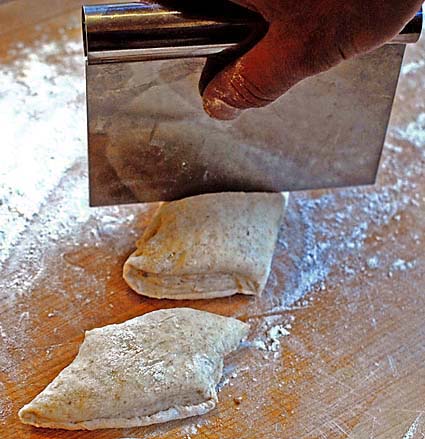
The buns will flatten from being cut, and they won’t appear to rise much before baking, but they get great oven “spring” (like all of our no-knead stored-dough recipes). Let the buns rest on parchment paper or a silicone pad for 20 to 40 minutes:
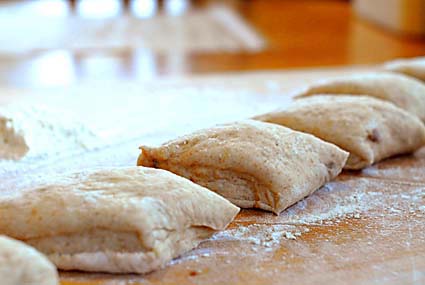
Preheat a baking stone to 450 degrees Fahrenheit (230 degrees Celsius) near the middle of the oven for 20 to 30 minutes, with a broiler tray to catch water on any other shelf that won’t interfere with the buns. Place the parchment or the silicone pad with the buns onto the stone, throw a cup of water into the broiler tray, and bake for about 20 to 25 minutes. You’ll get a gorgeous result, crusty and fragrant:

Wait at least an hour before breaking into them! Any sooner and the texture can be overly moist. Two hours is about perfect.

Note: Red Star Yeast (Lesaffre Corp) sponsored this post, and supplied yeast for recipe testing.
Note: BreadIn5.com is reader supported. When you buy through links on the site, BreadIn5 LLC earns commissions.
Those buns look pretty nice, and they’re probably excellent too, thanks Jeff and Zoe!
Would’nt it be possible to mix the whole batch of dough without the “old” dough and then knead in the “old” dough, like one usually does with firm sourdough? I know you want to have a no-knead dough but really, is that more complicated than using and then washing an immersion blender? It’s really easy to knead a piece of old dough in a batch of fresh dough.
Thanks again for your great recipes and ideas!
Hi again Flo! Especially if the old and new stuff are different (eg., whole wheat and white), it will be nice to have a more uniform mixture. I don’t find it all that easy to get the two doughs anywhere close to uniform when I try to knead things together. Sometimes I really enjoy that “marbled” effect.
Mainly, I’m a bit lazy! The business end of the immersion blender goes right into the dishwasher… Jeff
Mmm.. Nice Buns, lol.. ;o)
I gotta get a kitchen scale.. These look really good.
Seems like such hard work to make these Baguettes.. But I am sure it is worth it… BTW.. your pictures are great…thank you for sharing the recipe for Baguettes..
Andy
http://www.recipebuddys.com
Thanks Andy… I promise, the buns are easy, just stretch out a baguette and cut it into pieces and bake– maybe the step-by-step makes it seem harder than it is? Jeff
Zoe and Jeff,
thanks for a great book! quick question, can I use spelt flour as a substitute for whole wheat flour in your recipes?
thanks again,
david
David: We’re hard at work testing spelt flour for our next book (Healthy Bread in Five Minutes a Day is the tentative title). If you keep the spelt at the levels we use whole wheat, you should be OK (not for the 100% whole wheat recipe though). Light Whole Wheat (page 74) should be fine with spelt subbing for WW. For now just keep the spelt to 1 cup or less in the recipes. Jeff
Thank you once again for another great recipe and for the wonderful S-B-S photos. I’ll be making these tomorrow… can’t wait to tear into one!
Thanks F&L… what are S-B-S photos? Jeff
Those look wonderful – I’m going to have to make some!!
S-B-S is Step By Step!
Last weekend I was watching a 2 year old and we made gourmet pigs in a blanket using dough from the master recipe. They were really good!!
we rolled out the dough, cut it into rectangles, put some cheese on the dough, placed the piggie on the rectangle, added some ketchup and mustard and then joined the dough at the top of the piggie. Let the dough rise, sprinkled with poppy seeds and paprika (the 2 year old thought they needed some spices – he helped make them!) and baked them for about 20 minutes at 375. They were beautiful and tasty.
Duh to me!
You know, we should probably put pigs in blanket in our next book! Got to figure out a health-oriented alternative to hot dogs (don’t get me wrong, I love them). Thanks Gloria!
Thanks for the great instructions (again!) – they’re brilliant. I love that you’ve used weights here for measuring up.
And for David, it’s worth experimenting with spelt used as a direct substitute for wheat flour (especially if you’re allergic to wheat!). I’ve had great results with other bread recipes simply replacing regular wheat flour with spelt flour. Sometimes the results are a tad heavier, but they’re brilliant compared to other substitutes if you’ve had to go wheat-free.
Thanks again Jeff – this is a brilliant website.
Thank you Kathleen– we are busily experimenting with spelt and its cousin Emmer. I think the results will all make it into “Healthy Bread in Five Minutes a Day.”
Yeah, weights are probably the future. We’ll at least have equivalents in the next book. Jeff
Sorry Jeff, I guess I figured it was a given that S-B-S would be understood…
I got used to using it elsewhere for, Step-By-Step.
Thanks again for the recipe, even though I didn’t get them made like I thought they are first on my list for baking bread when I get a chance.
oops, guess I should’ve read the post after mine…
anyways, I’ll try to let you know how mine turned out.
As someone who bakes breads, I just wanted you to know I was introduced to you and your book by a chef friend of mine. The technique intrigued me so I checked out your website and the original video. I was impressed. I’m slowly baking my way through your book. Friends and dinner guests have been so impressed with the simplicity that I have taught them the technique. Needless to say, this has resulted in the purchase of the book by them and are passing along to their friends. One guest will be giving the book to friends for Christmas. Way to go.
Thank you Bill, what a great note to get. Please come back with questions of upi have any, anytime. We so appreciate your putting out the word on our book, that’s the way we’ve been able to reach people– through word of mouth. Jeff
I’m going to try these out.
I’ve actually been incorporating a fairly large amount of old dough in all the recipes of the book. It’s always worked brilliantly.
I just put the water over the old dough and leave it to soften. Then I just carry on with the recipe.
I can’t wait for your new book!! I sthere any way to reserve it?
Also meant to say that I heartily agree with Bill’s post above.
I’ve baked all our bread for the past 5 years or so and always enjoyed it. But with 2 babies to love and care for, anything that simplifies my life is a blessing. Your techniques simplify my life immensely but more importantly they result in the best bread ever – like I’ve said before, your breads are far better than most breads I’ve had back home in France!
Jeff and Zoe, I finally had my Artisan Bread in Five Party. There were 11 particiants. I asked them to bring only the Unbleached Un bromated a p flour and a bowl or two..I supplied the rye flour, the semolina flour, the yeast, the coarse salt, the zaatar spice, the extra ingredients for the pumpernickel,and the whole wheat flour. I made a “nook” for each baker each with one of the recipes from your book. Each “nook” had a different recipe to try. I began by shaping two loaves, which I had in the fridge, the Spinach Feta Bread, and the Olive oil SunDried tomato bread. While it was rising, I put together the basic boule in five minutes, of course.
I then had every one go to one of the stations, and make the recipe that was there. After they were made up, we weighed the dough right away and put them into plastic bags. Now each participant could share with each other as desired and take home more than one recipe of dough. The spinach and tomato loaves were baked and we all tasted them along with some other sweets I had prepared ahead of time. There were at least five books brought to the class, so it helped everyone to find the right techniques to properply prepare the dough that they were taking home. Most were amazed at the quickness of making bread. I’m sure more will be buying the book. One place even said they did not have anymore to sell!! I read that you are planning a new version of “healthier” breads, I’ll surely want that one, too. I hope to have another class soon, as it was just so much fun..thanks again for your wonderful method. We still eat only those breads!!! Why buy!! Louise Byron
Thank you for partying with us, Louise! Now I feel like I was there. This is better than any advertising our publisher could have gotten.
Hmm, you’re giving me good ideas for how to promote the book…
Magali: Thanks again for the France comparison, we swoon a bit when we read that.
As for reserving the book, the only way I know of is to pre-order it. That doesn’t even become possible until 4 to 8 weeks before publication date, which at the moment is December 2009. Thanks for your enthusiasm! Jeff
Very cool. I don’t know why I never thought to make rolls from this dough. love the immersion blender idea.
Thanks Alexandra. I should have said somewhere in here that you can use a higher whole-grain dough with similar results. Someone pointed out to us that the Federal government says that you need 51% whole grain by weight to call something “whole-grain.” Jeff
I tried these today with 1/2 C ground flaw seed and took away 1/2 C of the flour. Yummy! Thank you.
Harmony: I was hoping people would play with these, your variation sounds great!
Hi,
I don’t have your book, but intend to order it very soon. While reading the reviews I came across a youtube video and mixed up a batch of dough. I would like to bake the bread today if someone can answer my question in time. Could I put fresh garlic cloves…whole or coarsly chopped right in the unbaked dough instead of making garlic bread after it is baked? If so, how much would you recommend to have a nice garlic flavor. Also, what temperature do you bake the basic loaf on and for how long? Is it the same temperature for the whole time? How big is the loaf? Can you bake two loaves on the same pan at once?
Thanks!
Hi Sherry,
You can add garlic and it is wonderful. We have a recipe that has you roast the garlic first, but you can also add it raw. I like lots of it so you be the judge as to how much you think it tasty. If you add it raw I would cut it up first so that you are sure it will bake completely.
You can follow the same instructions that Jeff has described in this post for baking.
Thanks, Zoë
Thank you! I didn’t get your answer in time to add the garlic, but I will try that tomorrow. The crust on this bread is wonderful! Mine tastes just a little salty…I only had coarse kosher salt so maybe 1 1/2 tbsp. was too much? I will definitely order your book so I can try all your recipes.
Thanks again!
We use kosher salt as well (Morton brand), but check out the post on brands and how they may differ in measurement https://artisanbreadinfive.com/?p=139.
In general, Zoe and I are salt-lovers, and if you’re finding our recipes a little to salty, just adjust down. Try decreasing it by 25% or more and see what you think. Jeff
Flour question: Semolina Flour states it is milled from durum wheat.. ingredients durum wheat, niacin, iron, thiamine, mononitrate, riboflavin, and folic acid.
Durum flour states it’s ingredients are; durum flour, niacin, ferrous sulfate, thiamine, mononitrate, riboflavin, and folic acid.. Are they interchangeable?
Louise
Semolina is the flour made from durum wheat, so they should be interchangeable. The only differences may be the fineness of the grind. The finer the better, though the rougher stuff will work also.
Thanks, Jeff
Hello, I now have your cookbook and can’t wait to get started! I had already made the basic bread and roasted garlic/potato from the recipes online and they were both wonderful.
I just checked on the book errors so I could make corrections and found that only about half of them were really errors…was there a more recent printing where part of them were already corrected? I just want to make sure I got them all.
Thanks!
Hi Sherry,
I just had a bit of an admin problem and accidentally erased Jeff’s response to your comment! Sorry to both!
The answer is yes, there were a few errors that were cleaned up in later printings of the book. If you have a more recent copy then some of the things on our error page will have been corrected,
Thanks and enjoy all the bread!
Zoë
I am baking bread today. First loaf was wonderful – baking all the dough today. Any suggestions for freezing the baked bread? I used the master recipe and shaped into boules. Thanks.
Welcome to the site Judy! You can freeze unused bread in an airtight bag or container. If you like, once it defrosts, you can freshen it up by foil-wrapping it and giving it 10 minutes in a 400 degree oven.
So glad your first loaf turned out well! Jeff
I am so pleased with the results. I can’t wait to show off my homemade breads to my husband when he returns from deer hunting!
thanks for the freezer tip.
Judy
Did someone say “venison sausage rolls?” In a class that Zoe and I just did, one of the participants brought in some sausage rolls made from both enriched and non-enriched doughs from our book. They were great, and this was with supermarket sausage… Jeff
Good morning…I have a question about the whole wheat bread on page 76. I mixed the dough last night and after 3 hrs. it wasn’t doubled, but almost so I put it in the fridge. Was that okay or should I have left it longer? This morning I weighed a 1 1/2 lb. lump and rounded it into a ball and when I put it into the pan it came to the top so I shaped it more into an oblong to fit better. My pans are either 8 x 4 or 9 x 5. Is there a loaf pan that is 9 x 4 or is that an error? Since my kitchen was so cold I put it in the oven on the proof cycle and let it rise for about 2 hrs….it still wasn’t over the top of the pan, but was definitely doubled. Is the proof cycle a good idea or should I have let it rise at the cooler temp. and left it as long as it took to double? I now have it in the oven and am hoping it turns out as well as the other breads I’ve tried! I also have Boule dough in the fridge and plan to try the Sun-Dried Tomato and Parmesan Bread. I roasted and froze my own tomatoes this year. Do you think it would be okay to substitute those? They might have more moisture than the store-bought ones.
Thank you for your help!
Good Morning Jeff and Zoe,
I just found your recipe in the Dec 08/Jan 09 Mother Earth News and have requested your book from my daughter for Christmas as she works at Barnes and Noble. I have my first batch going as we speak and am excited to try this. We lived in Germany and England for 11 years and I have missed the breads especially from Germany ever since we got back in 2000. I will be making the bread today since I am impatient and to see the difference in it waiting in the fridge. I am really hoping that this dough might turn out some “Brotchen” that compare to our old German Bakery also. Thank you so much for coming up with this method. I will be able to make the dough on the weekend and have fresh hot bread all week even when I work a long day. Looking forward to experimenting. Have you thought about having some forums on your site where devotees can share with each other?
Funny you should ask, Valentine. We’d thought that this setup would serve to create forums such as you suggest. But because readers can’t start a conversation thread and label it however they like, no one seems to use it that way. As soon as our 2nd book manuscript is safely at the publisher’s on January 2nd, we will think through how to solve that problem technically. The choice we made about what technology to use might prevent us from doing that easily, but keep in touch and we’ll see how it goes in 2009. Meanwhile feel free to try to start something in one of these posts and see if other readers might comment? Jeff
Hey, I just got the book and have yet to make many of the recipes but I was wondering if rather than yeast the bread could be made with sourdough starter, and if so how to substitute one for another. If you have any suggestions that would be great as I have a sourdough starter and would love to use it with this method.
Amy: I’ve used sourdough starter and it definitely works in this method. I’ve used about a cup-and-a-half of active starter instead of yeast, and if you keep the final dough nice and wet (per our videos at https://artisanbreadinfive.com/?page_id=63 ), this works. It’s temperamental though, so we decided not to put it in the book.
Less temperamental would be to use some sourdough in addition to some yeast, though I can’t say that I’ve tested that. Jeff
On my home from the gym today I’m stopping at the bookstore to pick up your book. For the life of me I don’t know why I’ve waited so long.
The answer to this question may be in the book, but how crucial is the baking stone to making these? I only have a pizza stone and I want to make more at once than the size of that will allow.
Sue: Thanks for trying our book!
We didn’t mean to draw such a distinction between a “baking” stone and a “pizza” stone. A pizza stone is just a round baking stone– it will work beautifully.
I think the stone is pretty important for the un-enriched free-form breads; you get a much nicer crust and the stone also evens out heat in ovens that don’t deliver heat perfectly. That said, you can make a decent loaf on a greased cookie sheet, parchment paper, or a silicone mat. Just take them off those 2/3s of the way through and finish on a shelf. Jeff
Lacking a pizza stone, Jeff and Sue, I have a PChef pizza stone designed for a toaster oven and since I make 1/2 lb loaves, I use it and it does great! This way I have enough bread for 1 person and it doesn’t get stale.
Are there any Yahoo groups? I’m going to have a look to see, but we could have a group there very easily.
Pat: Thanks for checking in about this, I’d heard about these tiny stones and meant to test them… sounds like that setup works. Here’s the yahoo group, it’s been super-active lately:
[email protected]
Thanks, Jeff. I went to Yahoo groups and found it, read the archives and have posted there. The Master Recipe I posted about that I added water to a couple of days ago made a couple of baguettes and then a loaf of raisin cinnamon and another of cheddar and bacon bread and is doing okay. It seemed to absorb the added water fine. This is amazing dough!
Thanks again,
Pat
Thanks Pat!
After seeing your recipe for the boule in the Oregonian recently I tried it, loved it and have repeated it several times. Marvelous bread! I have now purchased your book and I am excited to try some of the healthier recipes. Somehow, the large commercial bakeries manage to come up with a very light springy 100% wheat bread (although not too tasty). My experience with 100% whole wheat results in a hearty but bitter and heavy loaf. I noticed your recipe calls for more rest time than the boule and that the dough cannot be stored for as long. Do you have any other hints for making this as light as possible?